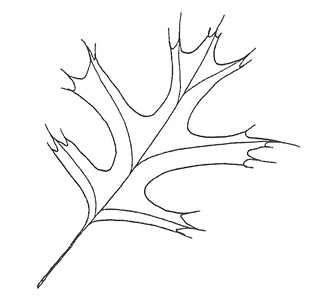Quercus palustris (kware’-kus pa-lus-‘tris)
Family: Fagaceae, Beech
Key Steps
- 1b – Alternate leaf arrangement — go to 18
- 18a – Leaf simple — go to 19
- 19b – Thornless — go to 22
- 22d – All leaves lobed — go to 23
- 19b – Thornless — go to 22
- 18a – Leaf simple — go to 19
Description
 Leaf: Lobes pointed, a very thin bristle on the top of each. 5-7 pairs of lobes. Sinuses reaching more than halfway to the central vein. Deep, untoothed sinuses. Leaf dark green, shiny above. Hair at vein axils beneath. Leaves clustered toward branch tip.
Leaf: Lobes pointed, a very thin bristle on the top of each. 5-7 pairs of lobes. Sinuses reaching more than halfway to the central vein. Deep, untoothed sinuses. Leaf dark green, shiny above. Hair at vein axils beneath. Leaves clustered toward branch tip.
Bud: Terminal bud under 3/16 inch long; narrow, sharp, hairless. Lateral buds stick out. Lots of buds clustered toward branch tip.
Leaf Scar: Half round. More than 3 bundle scars.
Stem: Slender. Many pin-like, stubby stems at end of each branch.
Pith: Solid, 5-angled or star-shaped. Pale brown.
Flower: Male catkins to 3 inches long, yellow-green at base of new growth. Female catkins grow in axils of new growth.
Fruit: 1/2 inch diameter acorn. Cup brownish and hairless, shallow, saucer-like, 1/4 inch high.
Habit: Pyramidal when young. Large broad shade tree when older. Lower branches droop, middle branches horizontal, upper branches rising. 40-50 feet tall.
Culture: Prefers moist, rich, acidic, well-drained soil. Prone to iron chlorosis in alkaline soils.
Resources




